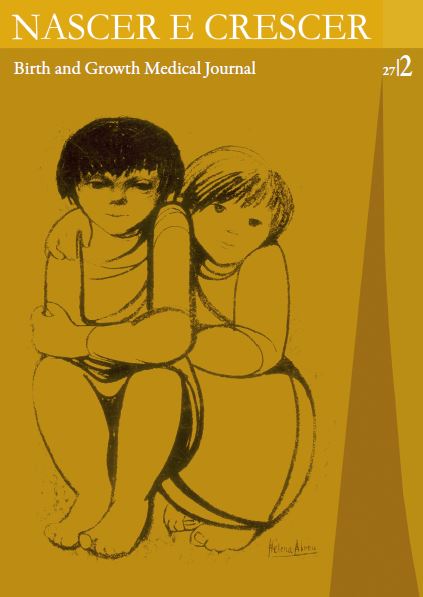Self-Concept and Disturbed Eating Behavior in a Clinical Population of Adolescents with Eating Disorders
DOI:
https://doi.org/10.25753/BirthGrowthMJ.v27.i2.13170Keywords:
Adolescents, Anorexia Nervosa, Bulimia Nervosa, Self-conceptAbstract
Introduction: Changes in self-concept have been considered to play a crucial role in the etiology of eating disorders. In this study, we evaluate the levels of self-concept and severity of the disturbed eating behavior in a clinical population of adolescents with Eating Disorders (ED) and study their correlations.
Method: A sample of 50 patients of an Adolescent Psychiatric Service completed two validated self-report scales: the Piers- Harris Children’s Self-concept Scale (PHCSCS) and the Eating Disorder Examination - Questionnaire (EDE-Q). Anthropometric data were also collected.
Results:Total self-concept had a negative correlation with disease severity [total EDE-Q (rs= -0.48)], as well as with four subscales of the EDE-Q [Dietary Restraint (rs =-0.30); Weight Concern (rs=-0.44); Shape Concern (rs=-0.56); and Eating Concern (rs=-0.40)]. Four of the PHCSCS subscales showed a negative correlation with the severity of the disease [Behavioral Adjustment (rs=-0.39); Freedom from Anxiety (rs=-0.56); Popularity (PO) (rs=-0.43) and Happiness and Satisfactions (HS) (rs=-0.39)]. Then the sample was divided into two groups: Compulsive / Purgative [5 Bulimia Nervosa (BN) + 3 Unspecified Feeding and Eating Disorder (UFED) with insufficient criteria for BN] and Restrictive (38 Anorexia Nervosa + 4 UFED with insufficient criteria for AN). The Compulsive / Purgative group had lower Self-concept than the Restrictive group (p <0.05). This first group also presented lower values than the Restrictive group in all subscales of the PHCSCS, but with statistical significance only in the Intellectual and School Status and HS. It also presented higher disease severity (p <0.05), with higher values in all four EDE-Q subscales, but with statistical significance only in Weight Concern (p <0.05).
Conclusions: These results are in agreement with the literature that the Self-concept is altered in ED. In our study, we report an inverse correlation between self-concept and dysfunctional eating behaviors. The Compulsive/Purgative group reported a lower self-concept and greater severity of the eating behavior pathology, but there were no clinical differences between the two groups. This finding may be explained by the lower morbidity awareness of the Restrictive group.
Downloads
References
Baumeister RF. Identity, self-concept, and self-esteem. In: Hogan R, Johnson JA, Briggs SR, editors. Handbook of Personality Psychology. Academic Press; 1997. p. 681-711.
American Psychiatric Association. American Psychiatric Association. DSM-5 Task Force. : Diagnostic and statistical manual of mental disorders : DSM-5. 5th ed. Washington D.C: American Psychiatric Association; 2013.
Jacobi C, Paul T, de Zwaan M, Nutzinger DO, Dahme B. Specificity of self-concept disturbances in eating disorders. Int J Eat Disord. 2004; 35:204-10.
Stein KF. The self-schema model: a theoretical approach to the self-concept in eating disorders. Arch Psychiatr Nurs, 1996; 10:96-109.
Jacobi C. Self-concept disturbances in patients with eating disorders. Zeitschrift für Klinische Psychologie-Forschung und praxis. 2000; 29:75-96.
Guidano VF, Liotti G. Cognitive processes and emotional disorders : a structural approach to psychotherapy. The Guilford clinical psychology and psychotherapy series. New York: Guilford Press; 1983.
Veiga FH. Escala de autoconceito: adaptação portuguesa do “Piers-Harris Children’s Self-Concept Scale”. Psicologia. 1989. 7: 275-84.
Machado PP, Martins C, Vaz AR, Conceição E, Bastos AP, Gonçalves S. Eating disorder examination questionnaire: psychometric properties and norms for the Portuguese population. Eur Eat Disord Rev. 2014; 22:448-53.
Butler RJ, Gasson SL. Self Esteem/Self Concept Scales for Children and Adolescents: A Review. Child and Adolescent Mental Health. 2005. 10:190-201.
Cooper Z, Fairburn C. The Eating Disorder Examination: a semi-structured interview for the assessment of the specific psychopathology of eating disorders. Int J Eat Disord. 1987; 6:1-8.
Tury F, Gulec H, Kohls E. Assessment methods for eating disorders and body image disorders. J Psychosom Res. 2010. 69:601-11.
Stein KF, Corte C. Identity impairment and the eating disorders: content and organization of the self-concept in women with anorexia nervosa and bulimia nervosa. European Eating Disorders Review. 2007; 15: 58-69.
Halmi KA, Sunday SR, Strober M, Kaplan A, Woodside DB, Fichter M, et al., Perfectionism in anorexia nervosa: variation by clinical subtype, obsessionality, and pathological eating behavior. Am J Psychiatry. 2000;157:1799-805.
Bernet CZ, Ingham RE, Johnson BR. Self-esteem. IN: Costello CG, editor. Symptoms of Depression. New York: Wiley; 1993. p. 141-59.
Downloads
Published
How to Cite
Issue
Section
License
Copyright and Authors' Rights
All articles published in Nascer e Crescer - Birth and Growth Medical Journal are Open Access and comply with the requirements of funding agencies or academic institutions. For use by third parties, Nascer e Crescer - Birth and Growth Medical Journal adheres to the terms of the Creative Commons License "Attribution - Non-Commercial Use (CC-BY-NC)".
It is the author's responsibility to obtain permission to reproduce figures, tables, etc. from other publications.
Authors must submit a Conflict of Interest statement and an Authorship Form with the submission of the article. An e-mail will be sent to the corresponding author confirming receipt of the manuscript.
Authors are permitted to make their articles available in repositories at their home institutions, provided that they always indicate where the articles were published and adhere to the terms of the Creative Commons license.


